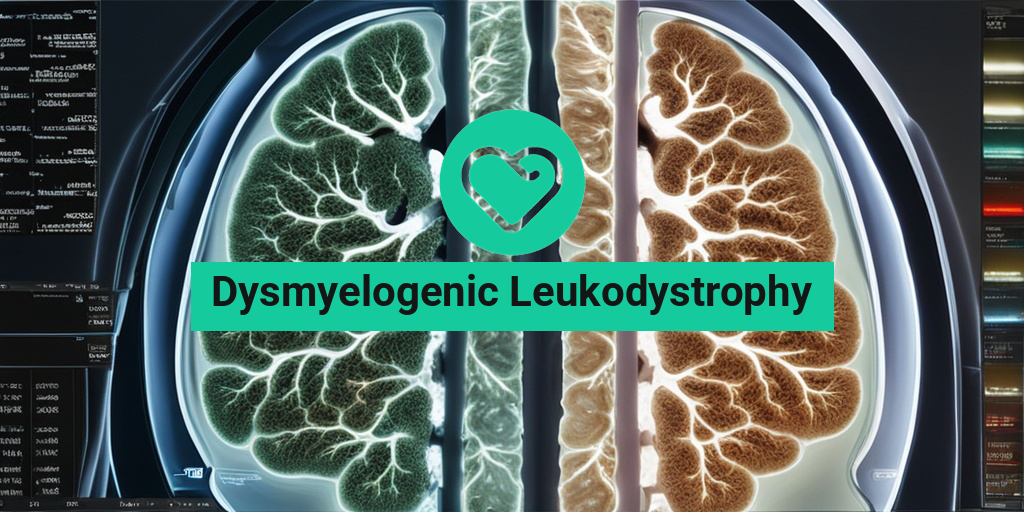“`html
What Is Dysmyelogenic Leukodystrophy?
Dysmyelogenic Leukodystrophy (DML) is a rare genetic disorder that affects the brain’s white matter, leading to a range of neurological issues. This condition is characterized by the improper formation of myelin, the protective sheath that surrounds nerve fibers. Myelin is crucial for the efficient transmission of electrical signals in the nervous system, and when it is damaged or absent, it can result in significant cognitive and motor impairments.
Understanding the Genetics Behind DML
Dysmyelogenic Leukodystrophy is often caused by mutations in specific genes responsible for the production and maintenance of myelin. These genetic mutations can be inherited in various patterns, including autosomal recessive or X-linked inheritance. Understanding the genetic basis of DML is essential for diagnosis and potential treatment options.
How Common Is Dysmyelogenic Leukodystrophy?
DML is considered a rare disorder, with an estimated prevalence of 1 in 100,000 to 1 in 1,000,000 individuals. Due to its rarity, many healthcare professionals may not be familiar with the condition, which can lead to delays in diagnosis and treatment. Early recognition and intervention are crucial for improving outcomes for affected individuals.
Dysmyelogenic Symptoms
The symptoms of Dysmyelogenic Leukodystrophy can vary widely among individuals, depending on the severity of the condition and the specific areas of the brain affected. Here are some common symptoms associated with DML:
- Motor difficulties: Individuals may experience muscle weakness, coordination problems, and difficulty with balance.
- Cognitive impairments: Learning disabilities, memory issues, and challenges with problem-solving are common.
- Speech and language delays: Affected individuals may have trouble with speech development or may struggle to articulate their thoughts.
- Seizures: Some individuals with DML may experience seizures, which can vary in frequency and severity.
- Behavioral changes: Mood swings, irritability, and changes in social interactions can also occur.
Age of Onset
The age at which symptoms appear can vary significantly. Some children may show signs in infancy, while others may not exhibit symptoms until later in childhood or even adolescence. Early diagnosis is vital, as it can lead to more effective management strategies and support for the affected individual and their family.
Diagnosis and Testing
Diagnosing Dysmyelogenic Leukodystrophy typically involves a combination of clinical evaluation, genetic testing, and imaging studies such as MRI scans. These tests help to assess the extent of myelin damage and rule out other potential conditions. If you suspect that you or a loved one may have DML, it is essential to consult a healthcare professional who specializes in genetic disorders.
Managing Dysmyelogenic Leukodystrophy
While there is currently no cure for Dysmyelogenic Leukodystrophy, various management strategies can help improve the quality of life for affected individuals. These may include:
- Physical therapy: To enhance motor skills and coordination.
- Speech therapy: To address communication challenges.
- Occupational therapy: To assist with daily living activities.
- Medications: To manage symptoms such as seizures or behavioral issues.
Support from healthcare professionals, family, and community resources is crucial for individuals with DML and their families. Organizations and platforms like Yesil Health AI can provide valuable evidence-based health answers and support for those navigating this complex condition.
Conclusion
Dysmyelogenic Leukodystrophy is a challenging condition that requires a comprehensive approach to diagnosis and management. By understanding the symptoms and seeking appropriate care, individuals and families can work towards improving outcomes and enhancing the quality of life. If you have concerns about DML or related symptoms, don’t hesitate to reach out to a healthcare professional for guidance. Remember, early intervention can make a significant difference! 🌟
“`

“`html
Dysmyelogenic Causes
Dysmyelogenic Leukodystrophy is a rare genetic disorder that affects the myelin sheath, the protective covering of nerve fibers in the brain and spinal cord. Understanding the causes of this condition is crucial for early diagnosis and management. Here, we delve into the primary causes of Dysmyelogenic Leukodystrophy.
Genetic Mutations
The most significant cause of Dysmyelogenic Leukodystrophy is genetic mutations. These mutations can occur in various genes responsible for the production and maintenance of myelin. Some of the key genes associated with this condition include:
- PLP1 (Proteolipid Protein 1): Mutations in this gene are often linked to X-linked forms of leukodystrophy.
- MBP (Myelin Basic Protein): Changes in this gene can disrupt myelin formation.
- GJC2 (Gap Junction Protein, Alpha 2): This gene is involved in the communication between glial cells, which are essential for myelin maintenance.
These genetic mutations can be inherited in various patterns, including autosomal dominant, autosomal recessive, and X-linked inheritance. Understanding the genetic basis of Dysmyelogenic Leukodystrophy can help in genetic counseling and family planning for affected individuals.
Environmental Factors
While genetic factors play a predominant role, certain environmental factors may also contribute to the development of Dysmyelogenic Leukodystrophy. These factors can include:
- Infections: Some viral infections during pregnancy may increase the risk of neurological disorders in the offspring.
- Exposure to toxins: Environmental toxins, such as heavy metals or certain chemicals, may impact myelin development.
Although these environmental factors are not direct causes, they can interact with genetic predispositions, potentially leading to the onset of the disorder.
Dysmyelogenic Risk Factors
Identifying the risk factors associated with Dysmyelogenic Leukodystrophy is essential for early detection and intervention. Here are some key risk factors to consider:
Family History
A family history of leukodystrophies or other genetic disorders significantly increases the risk of Dysmyelogenic Leukodystrophy. If there are known cases in the family, genetic counseling is highly recommended to assess the risk for future generations.
Ethnic Background
Some genetic disorders, including Dysmyelogenic Leukodystrophy, are more prevalent in certain ethnic groups. For instance, individuals of Ashkenazi Jewish descent have a higher incidence of specific genetic mutations associated with leukodystrophies. Awareness of these demographic factors can aid in early diagnosis and management.
Age and Gender
While Dysmyelogenic Leukodystrophy can affect individuals of any age, symptoms often manifest in early childhood. Additionally, certain forms of the disorder may show a gender bias, with males being more frequently affected than females, particularly in X-linked forms.
Pregnancy and Maternal Health
The health of the mother during pregnancy can also influence the risk of Dysmyelogenic Leukodystrophy. Factors such as maternal infections, nutritional deficiencies, and exposure to harmful substances can impact fetal development and increase the likelihood of neurological disorders.
In conclusion, understanding the causes and risk factors associated with Dysmyelogenic Leukodystrophy is vital for effective management and support for affected individuals and their families. Early diagnosis and intervention can significantly improve outcomes and quality of life for those impacted by this condition. 🌟
“`

“`html
Dysmyelogenic Diagnosis
Dysmyelogenic Leukodystrophy is a rare genetic disorder that affects the myelin sheath, the protective covering of nerve fibers in the brain and spinal cord. Diagnosing this condition can be challenging due to its complex nature and the variety of symptoms it presents. Early and accurate diagnosis is crucial for effective management and treatment.
Understanding Symptoms
The symptoms of Dysmyelogenic Leukodystrophy can vary widely among individuals, but common signs include:
- Developmental delays: Children may experience delays in reaching developmental milestones.
- Motor difficulties: Weakness, stiffness, or coordination problems can arise.
- Cognitive impairments: Issues with memory, attention, and learning may be observed.
- Seizures: Some individuals may experience seizures as the condition progresses.
- Behavioral changes: Mood swings or changes in personality can occur.
Diagnostic Tests
To diagnose Dysmyelogenic Leukodystrophy, healthcare providers typically employ a combination of the following tests:
- Magnetic Resonance Imaging (MRI): This imaging technique is essential for visualizing the brain’s structure and identifying abnormalities in the myelin sheath.
- Genetic testing: A blood test can reveal mutations in genes associated with dysmyelogenic disorders.
- Neurological examination: A thorough assessment of motor skills, reflexes, and cognitive function helps in understanding the extent of the disorder.
- Metabolic testing: This may include urine tests to check for metabolic disorders that could mimic or contribute to symptoms.
Importance of Early Diagnosis
Early diagnosis of Dysmyelogenic Leukodystrophy is vital for several reasons:
- Timely intervention: Early treatment can help manage symptoms and improve quality of life.
- Family planning: Understanding the genetic nature of the disorder can assist families in making informed decisions about future pregnancies.
- Access to support: Early diagnosis opens the door to resources and support networks for affected families.
Dysmyelogenic Treatment Options
While there is currently no cure for Dysmyelogenic Leukodystrophy, various treatment options can help manage symptoms and improve the quality of life for those affected. Treatment plans are often tailored to the individual’s specific needs and may involve a multidisciplinary approach.
Medications
Medications can play a crucial role in managing symptoms associated with Dysmyelogenic Leukodystrophy. Some common medications include:
- Anticonvulsants: These are prescribed to control seizures.
- Muscle relaxants: These can help alleviate muscle stiffness and spasms.
- Cognitive enhancers: Medications that support cognitive function may be beneficial for some patients.
Physical and Occupational Therapy
Therapies are essential components of a comprehensive treatment plan:
- Physical therapy: This helps improve mobility, strength, and coordination.
- Occupational therapy: Focuses on enhancing daily living skills and promoting independence.
Supportive Care
Supportive care is vital for individuals with Dysmyelogenic Leukodystrophy. This may include:
- Nutritional support: Ensuring proper nutrition is crucial, especially if swallowing difficulties arise.
- Palliative care: For advanced stages, palliative care can help manage pain and improve comfort.
- Psychological support: Counseling and support groups can provide emotional assistance for both patients and families.
Research and Future Directions
Ongoing research into Dysmyelogenic Leukodystrophy is promising. Scientists are exploring gene therapy and other innovative treatments that may one day offer more effective options for managing this condition. Staying informed about new developments can empower families and patients to make the best choices for their care.
“`

“`html
Dysmyelogenic Management Strategies
Dysmyelogenic Leukodystrophy is a rare genetic disorder that affects the myelin sheath, which is crucial for the proper functioning of the nervous system. Managing this condition requires a comprehensive approach that includes medical, therapeutic, and supportive strategies. Here, we will explore various management strategies that can help improve the quality of life for individuals affected by this condition.
1. Medical Interventions
Medical management of Dysmyelogenic Leukodystrophy often involves a multidisciplinary team of healthcare professionals. Here are some key medical interventions:
- Medications: Depending on the symptoms, medications may be prescribed to manage seizures, muscle spasticity, or other neurological symptoms.
- Gene Therapy: Although still in experimental stages, gene therapy holds promise for treating genetic disorders by correcting the underlying genetic defects.
- Regular Monitoring: Frequent check-ups with neurologists and geneticists are essential to monitor the progression of the disease and adjust treatment plans accordingly.
2. Physical and Occupational Therapy
Therapies play a vital role in enhancing the functional abilities of individuals with Dysmyelogenic Leukodystrophy:
- Physical Therapy: Tailored exercise programs can help improve mobility, strength, and coordination. Therapists may use techniques such as stretching and strengthening exercises to combat muscle weakness.
- Occupational Therapy: This therapy focuses on helping individuals perform daily activities. Occupational therapists can provide adaptive tools and strategies to enhance independence.
3. Nutritional Support
Nutrition is a critical aspect of managing Dysmyelogenic Leukodystrophy. A well-balanced diet can help support overall health and well-being:
- Consult a Dietitian: Working with a registered dietitian can help create a personalized nutrition plan that meets the specific needs of the individual.
- Hydration: Ensuring adequate fluid intake is essential, especially if swallowing difficulties are present.
4. Psychological Support
The emotional and psychological impact of Dysmyelogenic Leukodystrophy can be significant. Support systems are crucial:
- Counseling: Professional counseling can help individuals and families cope with the emotional challenges associated with the diagnosis.
- Support Groups: Connecting with others facing similar challenges can provide comfort and shared experiences.
Dysmyelogenic Outlook and Prognosis
The prognosis for individuals with Dysmyelogenic Leukodystrophy varies widely based on several factors, including the specific genetic mutation, age of onset, and the severity of symptoms. Understanding the outlook can help families prepare for the future.
1. Variability in Symptoms
Symptoms of Dysmyelogenic Leukodystrophy can range from mild to severe, affecting the prognosis:
- Early Onset: Children diagnosed at a young age may experience more severe symptoms and a more rapid decline in neurological function.
- Late Onset: Individuals diagnosed later in life may have a milder form of the disease, leading to a better overall prognosis.
2. Life Expectancy
Life expectancy for individuals with Dysmyelogenic Leukodystrophy can vary significantly:
- Severe Cases: In severe cases, life expectancy may be significantly reduced, often due to complications related to the disease.
- Milder Cases: Those with milder forms may lead relatively normal lives, with life expectancy approaching that of the general population.
3. Ongoing Research
Research into Dysmyelogenic Leukodystrophy is ongoing, with scientists exploring new treatment options and potential therapies:
- Clinical Trials: Families are encouraged to consider participation in clinical trials, which may provide access to cutting-edge treatments.
- Advancements in Gene Therapy: As research progresses, gene therapy may offer hope for more effective treatments in the future.
In conclusion, while Dysmyelogenic Leukodystrophy presents significant challenges, a combination of medical, therapeutic, and supportive strategies can help manage the condition and improve the quality of life for affected individuals. Ongoing research continues to provide hope for better outcomes in the future. 🌟
“`

“`html
Frequently Asked Questions about Dysmyelogenic Leukodystrophy
What is Dysmyelogenic Leukodystrophy?
Dysmyelogenic Leukodystrophy is a rare genetic disorder that affects the development of myelin, the protective sheath surrounding nerve fibers in the brain and spinal cord. This condition can lead to various neurological symptoms and developmental delays.
What are the symptoms of Dysmyelogenic Leukodystrophy?
- Delayed motor skills development
- Muscle weakness or stiffness
- Seizures
- Difficulty with coordination and balance
- Cognitive impairments
How is Dysmyelogenic Leukodystrophy diagnosed?
Diagnosis typically involves a combination of clinical evaluation, imaging studies such as MRI, and genetic testing to identify specific mutations associated with the disorder.
What treatments are available for Dysmyelogenic Leukodystrophy?
Currently, there is no cure for Dysmyelogenic Leukodystrophy. Treatment focuses on managing symptoms and may include:
- Physical therapy
- Occupational therapy
- Medications to control seizures
- Supportive care to improve quality of life
Is Dysmyelogenic Leukodystrophy hereditary?
Yes, Dysmyelogenic Leukodystrophy is often inherited in an autosomal recessive manner, meaning that both parents must carry a copy of the mutated gene for their child to be affected.
What is the prognosis for individuals with Dysmyelogenic Leukodystrophy?
The prognosis varies widely depending on the severity of symptoms and the age of onset. Early intervention and supportive therapies can help improve outcomes and quality of life.
Where can I find support for Dysmyelogenic Leukodystrophy?
Support groups and organizations dedicated to rare genetic disorders can provide valuable resources and community support for families affected by Dysmyelogenic Leukodystrophy. Online forums and local advocacy groups can also be helpful.
Are there any ongoing research efforts for Dysmyelogenic Leukodystrophy?
Yes, researchers are actively studying Dysmyelogenic Leukodystrophy to better understand its causes and develop potential treatments. Clinical trials may be available for affected individuals.
“`




